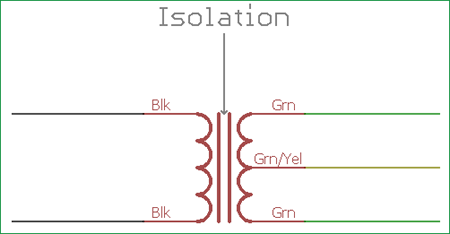Do you have an after market stereo, or original? I battled with a buzz on one door, and replaced the door amp - it went away. It returned a couple of years later and I have now increased the resistance between the output of my after-market stereo and the door amp (my incartec harness uses inline variable resistors to all 4 doors) so far the buzz went away.
You are using an out of date browser. It may not display this or other websites correctly.
You should upgrade or use an alternative browser.
You should upgrade or use an alternative browser.
P38A Radio produces a high pitched tone - is there a cure?
- Thread starter Rollover
- Start date
This site contains affiliate links for which LandyZone may be compensated if you make a purchase.
- Posts
- 3,252
- Location
- Near Heathrow.
You got lucky. The incartec & other similar just use resister bridges to adapt the speaker outputs to feed the door amps. It’s a bodge that works under two conditions.
1) the head unit must have floating speaker outs.
2) footwell & door amp connectors must be good.
if changing resistance works you have temporarily adjusted for bad connections.
1) the head unit must have floating speaker outs.
2) footwell & door amp connectors must be good.
if changing resistance works you have temporarily adjusted for bad connections.
- Posts
- 12,126
- Location
- Sud ouest France !
Another story..... I had the original head unit, no issues.You got lucky. The incartec & other similar just use resister bridges to adapt the speaker outputs to feed the door amps. It’s a bodge that works under two conditions.
1) the head unit must have floating speaker outs.
2) footwell & door amp connectors must be good.
if changing resistance works you have temporarily adjusted for bad connections.
I replaced it for a kenwood system, no issues.
I replaced that for a jvc Bluetooth, no sound!
I got the intec adapter after a recommendation from a nice fellow around here
Now after two years or so I was helping @RisforRacingnotReverse with his aftermarket stereo and test fitted it to my car to rule out issues and it worked without the adapter. I then refitted mine without the adapter and it worked as well??? Wtfunk ??
You got lucky. The incartec & other similar just use resister bridges to adapt the speaker outputs to feed the door amps. It’s a bodge that works under two conditions.
1) the head unit must have floating speaker outs.
2) footwell & door amp connectors must be good.
if changing resistance works you have temporarily adjusted for bad connections.
When adjusting a variable resistor that's meant to be adjusted is described as a bodge, god help us all - certainly beats what would no doubt be a fruitless exercise in pulling panels and checking connections. Footwell connector is already removed and soldered up anyway. It sounds like you will be sad if my fix proves to be permanent? Luckily I care not if technically I may have some bad connections somewhere, as long as my stereo sounds as it should.
- Posts
- 3,252
- Location
- Near Heathrow.
I didn't say adjusting a variable resistor was a bodge. But using resistors to adapt head unit Speaker outputs to feed a balanced input amplifier is.
If it's working for you, enjoy the stereo sounds.
If it's working for you, enjoy the stereo sounds.
- Posts
- 3,252
- Location
- Near Heathrow.
The transformers I used were Z1604 from Farnell UK, but better quality are available if you want. I used the Z1604 because they were cheaper, and I don't need heavy bass or above 20khz for my old ears !! The A262 are better quality, plus you can wire them to step-up the signal. (use one primary coil for the HU, and two secondary in series to the amps)
You need 5 of them, with one for each door amp, plus one for sub.
60 to 25kHz Frequency range
Z1604 OEP (Oxford Electrical Products) Transformer , Audio , PCB , 600R | eBay
30 to 35kHz Frequency range
A262A7E OEP (Oxford Electrical Products) Transformer , Audio , 1+1:1+1 | eBay.
The image below is generic, but for this example you would connect the two black wires to the HU Line Out, and the two green wires to the twisted pair that go to each door amplifier. Whatever transformers you get will be similar.
As long as the transformer impedance is 600ohms to 1.2kohms and covers the audio range from 50Hz to 20kHz it will work.

You need 5 of them, with one for each door amp, plus one for sub.
60 to 25kHz Frequency range
Z1604 OEP (Oxford Electrical Products) Transformer , Audio , PCB , 600R | eBay
30 to 35kHz Frequency range
A262A7E OEP (Oxford Electrical Products) Transformer , Audio , 1+1:1+1 | eBay.
The image below is generic, but for this example you would connect the two black wires to the HU Line Out, and the two green wires to the twisted pair that go to each door amplifier. Whatever transformers you get will be similar.
As long as the transformer impedance is 600ohms to 1.2kohms and covers the audio range from 50Hz to 20kHz it will work.
- Posts
- 15,144
- Location
- Benfleet, Essex
I have my P38 WOOFER producing a dull muddy thud, should I change his diet? 
- Posts
- 3,252
- Location
- Near Heathrow.
Music diet ? Probably
Similar threads
- Replies
- 5
- Views
- 763
- Replies
- 23
- Views
- 2K
- Replies
- 29
- Views
- 4K
